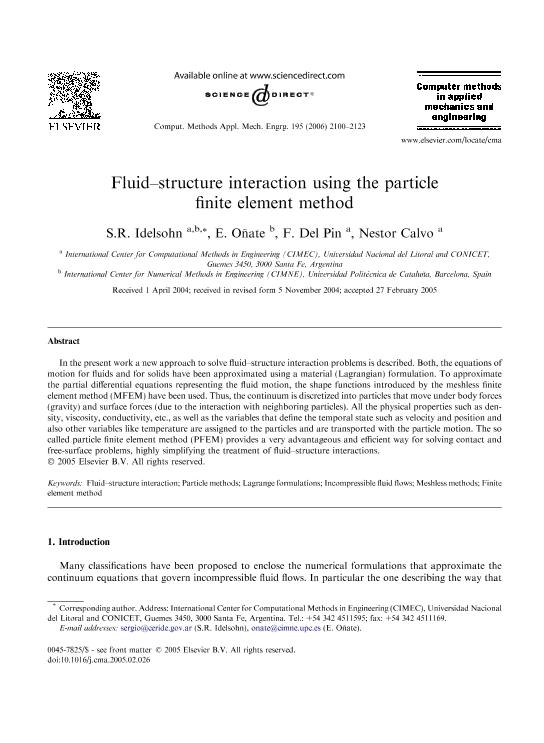Mostrar el registro sencillo del ítem
dc.contributor.author
Idelsohn, Sergio Rodolfo

dc.contributor.author
Oñate, Eugenio
dc.contributor.author
del Pin, Facundo
dc.contributor.author
Calvo, Nestor Alberto

dc.date.available
2017-07-27T15:20:03Z
dc.date.issued
2006-12
dc.identifier.citation
Idelsohn, Sergio Rodolfo; Oñate, Eugenio; del Pin, Facundo; Calvo, Nestor Alberto; Fluid-Structure Interaction Using the Particle Finite Element Method; Elsevier Science Sa; Computer Methods in Applied Mechanics and Engineering; 195; 17-18; 12-2006; 2100-2123
dc.identifier.issn
0045-7825
dc.identifier.uri
http://hdl.handle.net/11336/21448
dc.description.abstract
In the present work a new approach to solve fluid–structure interaction problems is described. Both, the equations of motion for fluids and for solids have been approximated using a material (Lagrangian) formulation. To approximate the partial differential equations representing the fluid motion, the shape functions introduced by the meshless finiteelement method (MFEM) have been used. Thus, the continuum is discretized into particles that move under body forces (gravity) and surface forces (due to the interaction with neighboring particles). All the physical properties such as density, viscosity, conductivity, etc., as well as the variables that define the temporal state such as velocity and position and also other variables like temperature are assigned to the particles and are transported with the particle motion. The so called particle finite element method (PFEM) provides a very advantageous and efficient way for solving contact and free-surface problems, highly simplifying the treatment of fluid–structure interactions.
dc.format
application/pdf
dc.language.iso
eng
dc.publisher
Elsevier Science Sa

dc.rights
info:eu-repo/semantics/openAccess
dc.rights.uri
https://creativecommons.org/licenses/by-nc-sa/2.5/ar/
dc.subject
Fluidstructure Interaction
dc.subject
Particle Methods
dc.subject
Lagrange Formulations
dc.subject
Incompressible fluid flows
dc.subject.classification
Ingeniería del Petróleo, Energía y Combustibles

dc.subject.classification
Ingeniería del Medio Ambiente

dc.subject.classification
INGENIERÍAS Y TECNOLOGÍAS

dc.title
Fluid-Structure Interaction Using the Particle Finite Element Method
dc.type
info:eu-repo/semantics/article
dc.type
info:ar-repo/semantics/artículo
dc.type
info:eu-repo/semantics/publishedVersion
dc.date.updated
2017-07-26T15:23:14Z
dc.journal.volume
195
dc.journal.number
17-18
dc.journal.pagination
2100-2123
dc.journal.pais
Países Bajos

dc.journal.ciudad
Amsterdam
dc.description.fil
Fil: Idelsohn, Sergio Rodolfo. Consejo Nacional de Investigaciones Científicas y Técnicas. Centro Científico Tecnológico Conicet - Santa Fe. Instituto de Desarrollo Tecnológico para la Industria Química. Universidad Nacional del Litoral. Instituto de Desarrollo Tecnológico para la Industria Química; Argentina
dc.description.fil
Fil: Oñate, Eugenio. Universidad Politecnica de Catalunya; España
dc.description.fil
Fil: del Pin, Facundo. Consejo Nacional de Investigaciones Científicas y Técnicas. Centro Científico Tecnológico Conicet - Santa Fe. Instituto de Desarrollo Tecnológico para la Industria Química. Universidad Nacional del Litoral. Instituto de Desarrollo Tecnológico para la Industria Química; Argentina
dc.description.fil
Fil: Calvo, Nestor Alberto. Consejo Nacional de Investigaciones Científicas y Técnicas. Centro Científico Tecnológico Conicet - Santa Fe. Instituto de Desarrollo Tecnológico para la Industria Química. Universidad Nacional del Litoral. Instituto de Desarrollo Tecnológico para la Industria Química; Argentina
dc.journal.title
Computer Methods in Applied Mechanics and Engineering

dc.relation.alternativeid
info:eu-repo/semantics/altIdentifier/url/http://www.sciencedirect.com/science/article/pii/S0045782505002008
dc.relation.alternativeid
info:eu-repo/semantics/altIdentifier/doi/http://dx.doi.org/10.1016/j.cma.2005.02.026
Archivos asociados
